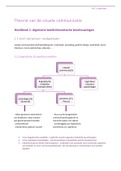College aantekeningen
PBMU Notes Lectures 1 to 12
- Instelling
- Vrije Universiteit Amsterdam (VU)
The document contains all notes made in the year 2022/2023 for the course 'Problematic and Beneficial Effects of New Media Use' of the Communication Sciences programme at the VU. The notes are complete and also clearly explain various tables and figures.
[Meer zien]











